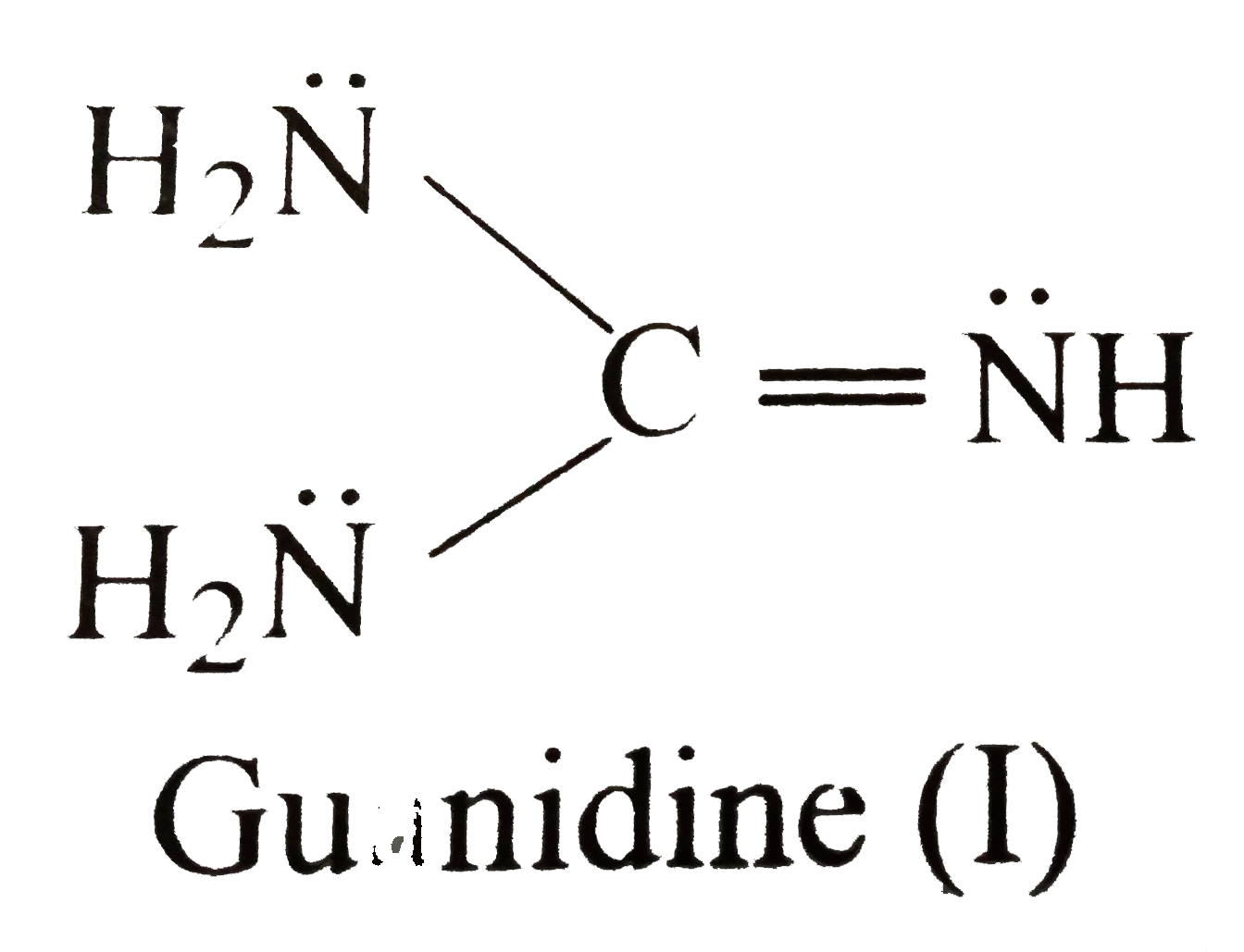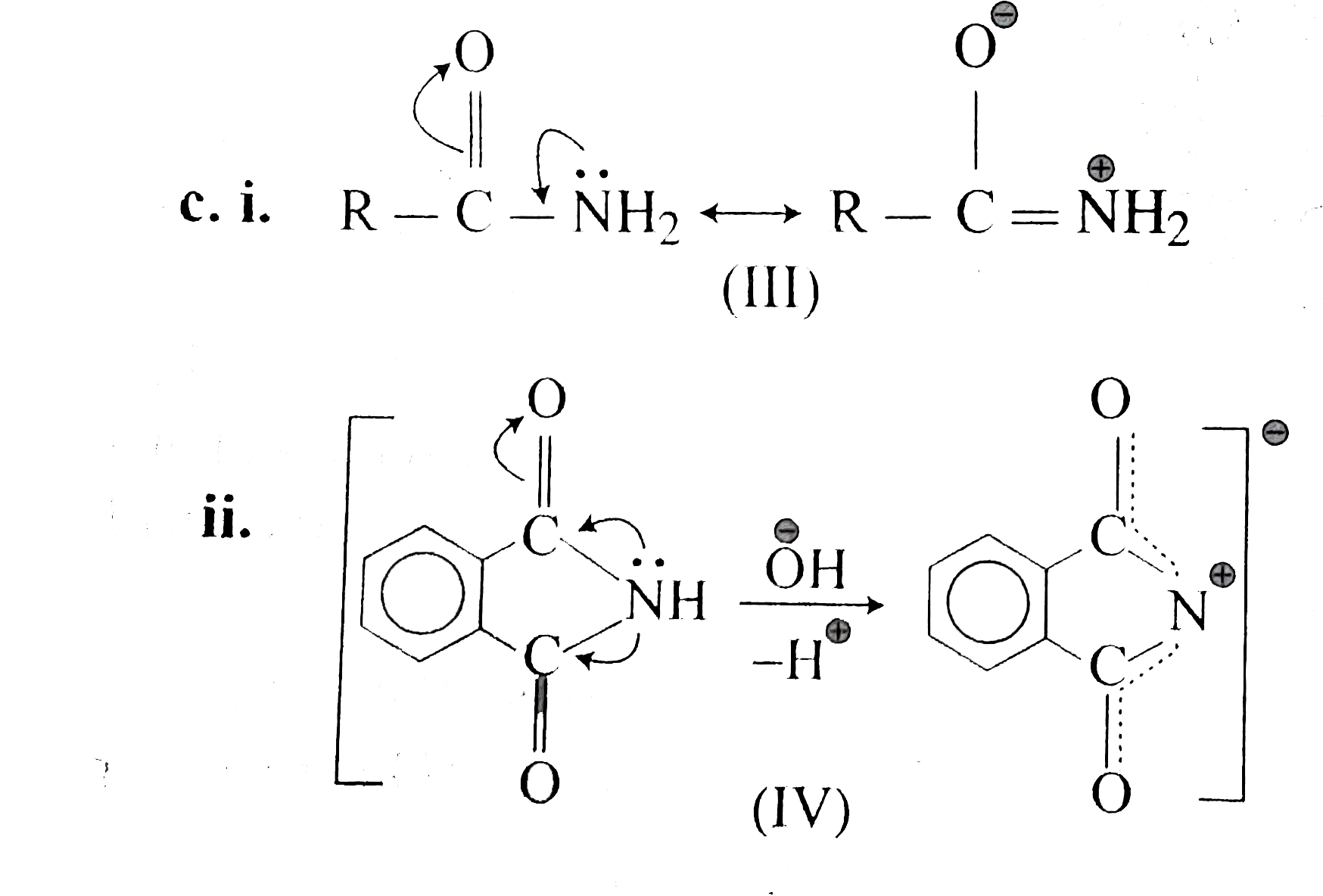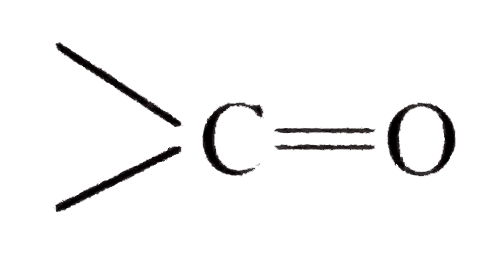(a) Which N of guanidine (I) is more basic and is more likely to be protonated ?
(b) Why guanidine is the strongest organic N−base (Kb≅1) ?
( c) Why amides (III) are weakly basic (amphoteric), whereas phthalimide (IV) is an acid ?
The lesser the s character (as in sp3HO,s), the stronger is the base. The N atom of NH2 group is sp3 hybrised with less s character than N of the imino (=NH) group. So, NH2 group is more basic and is more likely to accept proton from water solvent.

(b) Both guanidine and its conjugate acid, the guanidinium ion, are stabilished by delocalisation as shown below :

Guanidinium cation (II) is stabilished by the contribution of three exactly equivalent structures, whereas guanidine (I) has the resonating structures involving charge separation. Thus, the conjugate acid is more stable than the base and guanidine is, therefore, strong base.

Due to more resonance hybrid and extensive delocalisation in (IV) than (III).
Topper's Solved these Questions
- GENERAL ORGANIC CHEMISTRYBOOK - CENGAGE CHEMISTRYCHAPTER - GENERAL ORGANIC CHEMISTRYEXERCISE - Solved Example
18 Videos
- GENERAL ORGANIC CHEMISTRYBOOK - CENGAGE CHEMISTRYCHAPTER - GENERAL ORGANIC CHEMISTRYEXERCISE - Subjective
11 Videos
- CLASSIFICATION AND NOMENCLATURE OF ORGANIC COMPOUNDSBOOK - CENGAGE CHEMISTRYCHAPTER - CLASSIFICATION AND NOMENCLATURE OF ORGANIC COMPOUNDSEXERCISE - Analytical and Descriptive Type
3 Videos
- HYDROGEN, WATER AND HYDROGEN PEROXIDEBOOK - CENGAGE CHEMISTRYCHAPTER - HYDROGEN, WATER AND HYDROGEN PEROXIDEEXERCISE - Subjective Archive (Subjective)
3 Videos
Similar Questions
Knowledge Check
Amines are basic in nature due to the presence of lone pair of electrons on N atom of −NH2 group. The basic strength of amines can be expressed by their dissociation constant, Kb or pKb.
RNH2+H2→RNH+3+OH−
Kb=[RHH+3][OH−][RNH2] and pKb=−logKb
Greater the Kb value or smaller the pKb value, more is the basic strength of amine. Aliphatic amines are stronger bases than ammonia due to the electron releasing effect of alkyl groups. The basic strength among amines decreases as :
2∘>1∘>3∘
Aryl amines such as aniline are less basic than aliphatic amines due to the involvement of lone pair of electrons on N atom with the resonance in benzene. In derivatives of aniline, the electron releasing groups increase the basic strength while electron withdrawing groups decrease the basic strength. The base weakening effect of electron withdrawing group and base strengthening effect of electron releasing group is more marked at p-position than at m-position. Every o- substituted aniline is less basic than aniline due to ortho effect.
The strongest base among the following isAC6H5NH2Bp−NO2C6H4NH2Cm−NO2−C6H4NH2DC6H5CH2NH2Amines are basic in nature due to the presence of lone pair of electrons on N atom of −NH2 group. The basic strength of amines can be expressed by their dissociation constant, Kb or pKb.
RNH2+H2→RNH+3+OH−
Kb=[RHH+3][OH−][RNH2] and pKb=−logKb
Greater the Kb value or smaller the pKb value, more is the basic strength of amine. Aliphatic amines are stronger bases than ammonia due to the electron releasing effect of alkyl groups. The basic strength among amines decreases as :
2∘>1∘>3∘
Aryl amines such as aniline are less basic than aliphatic amines due to the involvement of lone pair of electrons on N atom with the resonance in benzene. In derivatives of aniline, the electron releasing groups increase the basic strength while electron withdrawing groups decrease the basic strength. The base weakening effect of electron withdrawing group and base strengthening effect of electron releasing group is more marked at p-position than at m-position. Every o- substituted aniline is less basic than aniline due to ortho effect.
Which of the following group does not decrease the basic strength of aniline ?A−OCH3B−NO2C−CND−halogen
Which do you think is a more basic characteristic for classifying organisms?
(a) the place where they live. (b) the kind of cells they are made of. Why?
View SolutionWhere do you think is more basic characteristic for classify organism ?
(a) the place where they live
(b) the kind of cells they are made of, why ?
View Solution(a) Explain why an alkylamine is more basic than ammonia?
(b) How would you convert:
(i) Aniline to nitrobenzene
(ii) Aniline to iodobenzene
View Solution(i) Explain why an alkylamine is more basic than ammonia.
(ii) How would you convert
(a) aniline to nitrobenzene, (b) aniline to iodobenzene ?
View SolutionAnswer the following with reasoning:
(i) Why all the acid derivatives (RCOG) [G may be -X (acid halides), −NH2 (amides), OR' (esters) or -OCOR (anhydrides)] are studied as a unit?
(ii) Why the C-G bond in acid derivatives is expected to be shorter and stronger than in alkyl derivatives (R-G)?
(iii) Why esters have lower boiling points than (a) ketones and (b) acids of comparable molecular masses?
(iv) Amongst the following amides, CH3CONH2,CH3CONHCH3andCH3CON(CH3)2, why acetamide has the highest boiling point and CH3CON(CH3)2 the minimum boiling point?
(v) How the order of reactivity of the acid derivatives is related to the base strength of the leaving groups?
(vi) Why cannot HCl convert RCOOHto RCOCl?
(vii) Why does an acyl chloride undergo nucleophilic attack more rapidly than does an alkyl chloride?
(viii) What is the essential difference between nucleophilic attack on the of an aldehyde or ketone and on an acyl derivative?
of an aldehyde or ketone and on an acyl derivative?
(ix) Why a ketone is not isolated from the reaction of an ester with one equivalent of RMgX?
(x) Amongst the following esters, CH3COOC4H9,CH3COOC3H7,CH3COOCH(CH3)2andCH3COOCH3 : why CH3COOCH3 is most readily hydrolysed with NaOH?
(xi) Why formic anhydride cannot be prepared by heating formic acid?
(xii) Primary and secondary amides exist as dimers in the solid and pure liquid state.
(xiii) Why urea is basic?
(xiv) Why guanidine is a strong monoacid base?
(xv) Why melting point of primary amide is higher than secondary and tertiary amides?
View SolutionOut of (CH3)3C−Brand(CH3)3C−I , which one is more reactive towards SN1 and why ?
View Solution
